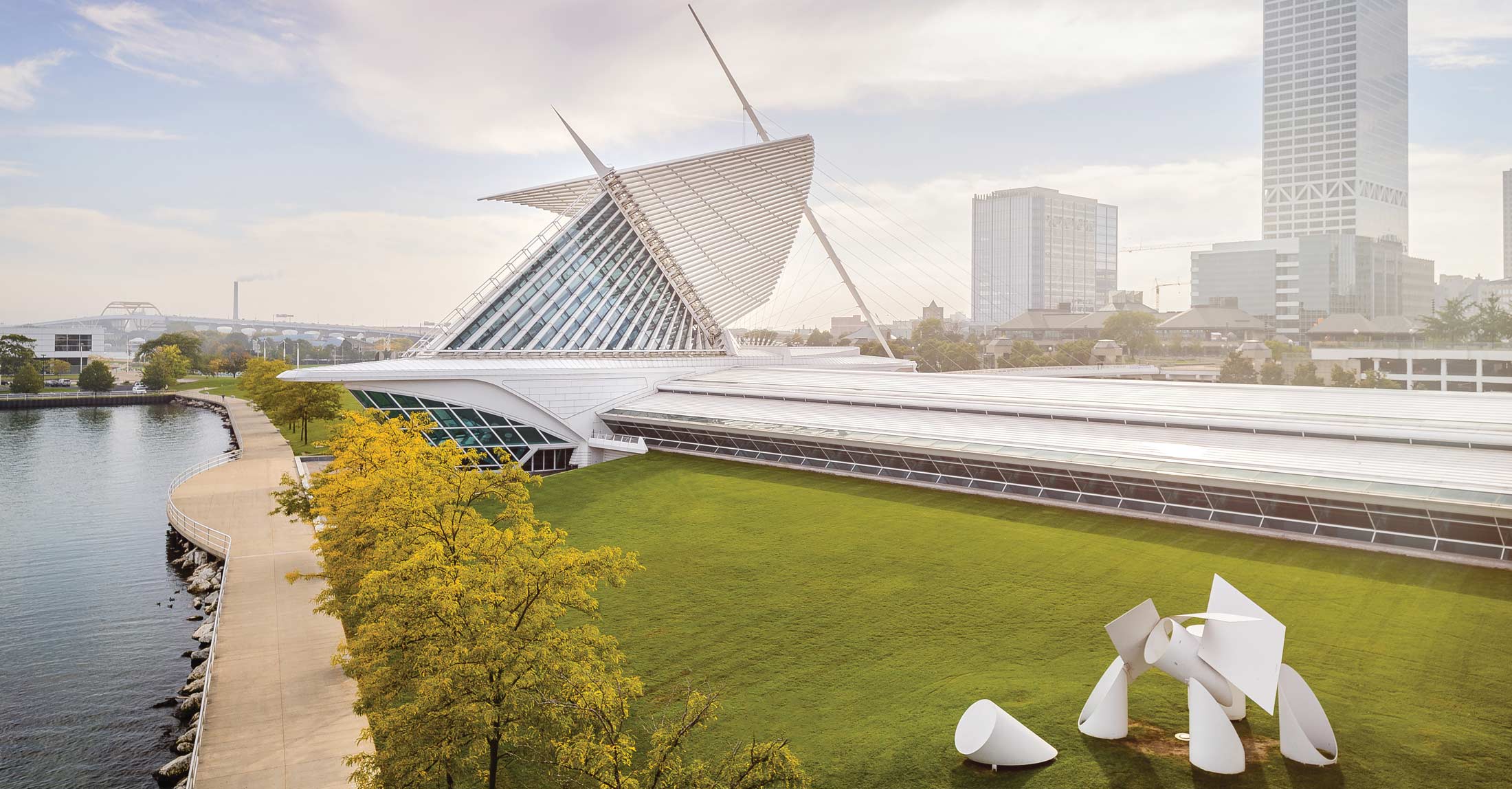
Museum Begins Ambitious Restoration and Reinstallation Project
Big changes happening at the Milwaukee Art Museum
Quadracci Pavilion remains open while Collection Galleries undergo major restoration
Milwaukee, Wis. – The Milwaukee Art Museum has started a comprehensive restoration project to repair two buildings on its campus, the Saarinen and the Kahler, and to reinstall its Collection Galleries. The $25 million project, done in partnership with Milwaukee County, which owns the two buildings, is expected to take one year.
The Quadracci Pavilion, known affectionately to Milwaukeeans as “the Calatrava,” is not part of the construction and will remain open and active. It will feature a full lineup of exhibitions, increased events, and a temporarily displaced Kohl’s Art Generation Studio that will be open during regular Museum hours, Tuesday through Sunday. The Collection Galleries, which are located inside the Saarinen- and Kahler-designed buildings and are scheduled for reinstallation, will be off view beginning October 20. Some galleries have already begun the transition.
“In spring of 2013, Milwaukee County made a generous $10 million contribution toward repairing the Saarinen and Kahler buildings, which house the Museum’s Collection. Thanks to this support, the damage that has accumulated over the years will be fixed,” said Daniel Keegan, Museum director. “In partnership with the County, and in recognition of our role in the community and as protectors of the art, the Museum will raise at least an additional $15 million to assist with the restoration and repairs, and to reinstall our Collection to improve the visitor experience.”
The Eero Saarinen–designed Milwaukee County War Memorial Center was built in 1957 and was designed as both a war memorial and an art gallery. The David Kahler addition was completed in 1975. Both buildings are owned by Milwaukee County. A leaky roof, mold infiltration, a failed HVAC system, broken concrete, leaking windows, and foundation seepage are among the problems to be remedied.
The reinstallation project will:
• Improve the environment for visitors and provide a safe home for the over 30,000 works of art in the Museum’s world-class Collection by repairing the Saarinen building and Kahler addition.
• Make it possible for more art to be on view to the public by significantly increasing gallery space.
• With the addition of a new lakeside entrance, establish easier public access to the Museum, the Collection, and a critical exhibition gallery—thereby providing a better visitor experience.
• Re-imagine how visitors approach the Collection and experience the art, through significant changes to the presentation of the art and a more intuitive layout.
• Conserve energy and improve the lighting of the art, with the installation of new LED bulbs throughout the Museum’s galleries.
• Add bathrooms on every level.
The Quadracci Pavilion was completed in 2001 and is owned by the Milwaukee Art Museum. It will not be affected by the repairs.
“As we begin this restoration process, I want to stress that the Museum remains open throughout the year. Most amenities, programs, events, tours, and activities, including Lakefront Festival of Art, MAM After Dark, Yoga, and our Kohl’s Art Generation Studio, will continue while the galleries are under repair,” said Keegan. “The Quadracci Pavilion will be active and engaging for our visitors, who can still experience art, visit the Museum Store and Café Calatrava, and enjoy the lakefront vistas. We have a stellar lineup of exhibitions that our visitors will not want to miss.”
Upcoming exhibitions include Of Heaven and Earth: 500 Years of Italian Painting from the Glasgow Museums, Inspiring Beauty: 50 Years of Ebony Fashion Fair, and Van Gogh to Pollock:Modern Rebels.
The Museum welcomes public donations as part of its restoration campaign, called the Plan for the Future.
“Public support of our initiative to restore the state’s most significant war memorial, as well as protect its most important art collection, is key,” said Keegan. “We want our visitors, supporters, and neighbors to know that they are integral to the success of the Museum. The Milwaukee Art Museum is a community treasure, and the Plan for the Future will reinvigorate the galleries and the Collection itself, making the Museum more accessible for tourists and visitors.”
HOURS AND ADMISSION
The Museum is open Tuesday–Sunday from 10 a.m. to 5 p.m., and on Thursdays until 8 p.m.
Admission is $14 for adults; $12 for students, seniors, and active military; and free for Members and for children age 12 and under. The first Thursday of each month is Target Free First Thursday and admission is free for individuals (does not apply to groups).
The Museum Store is open during regular Museum hours, Tuesday through Sunday.
Café Calatrava is open Wednesdays through Sundays, 11 a.m. to 4 p.m. The Coffee Shop is open Tuesdays through Sundays, 10 a.m. to 4 p.m.
ABOUT MILWAUKEE ART MUSEUM
Prominently situated on the shores of Lake Michigan, the Milwaukee Art Museum campus welcomes over 400,000 visitors annually. The Museum was founded over 125 years ago and is the largest and most significant art museum in Wisconsin. It houses a rich collection of over 30,000 works, with strengths in 19th- and 20th-century American
and European art, contemporary art, and American decorative arts. It is the world’s leading repository for work by untrained creators and has one of the largest collections of works by Georgia O’Keeffe. The Museum’s celebrated Santiago Calatrava–designed Quadracci Pavilion, completed in 2001, showcases both Museum-produced and traveling feature exhibitions.
RESTORE. REINSTALL. REIMAGINE.
Beginning in fall 2014, the Museum began an ambitious project to renovate its two oldest buildings, the Eero Saarinen–designed War Memorial Center (1957) and the David Kahler–designed addition (1975), which house the Museum’s Collection Galleries. Increased gallery space, including an entire floor dedicated to photography and new media, an improved gallery layout, and a new lakeside entrance are among the improvements planned. The collections will be off view through fall 2015; however, the Museum is open throughout construction, with a vibrant schedule of exciting exhibitions, educational offerings, and special programs in the Quadracci Pavilion. For more information, visit mam.org.
###
